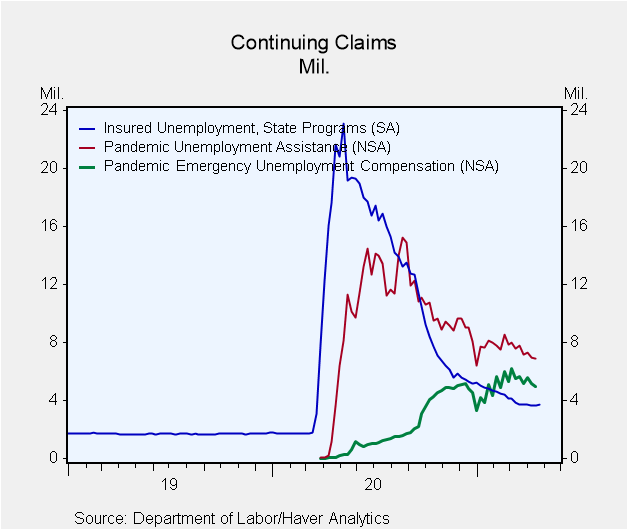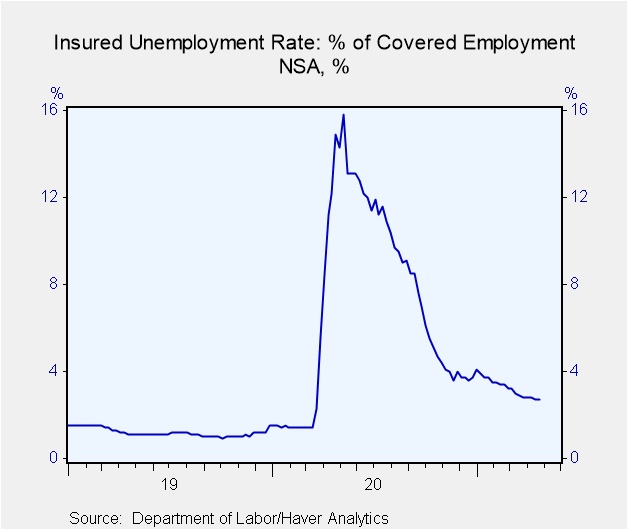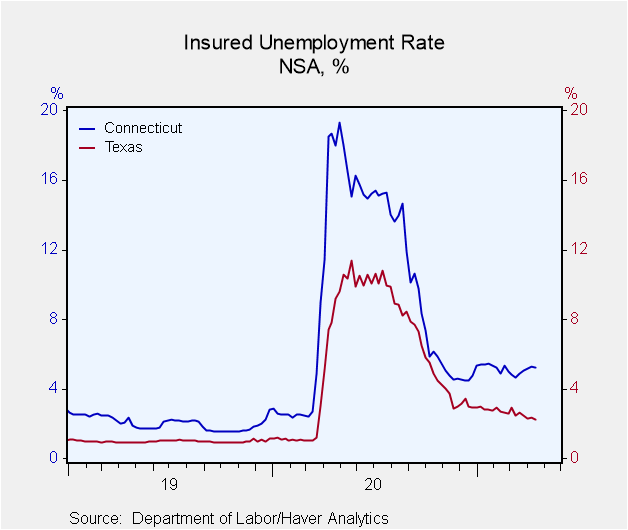 Global| May 06 2021
Global| May 06 2021U.S. Initial Unemployment Insurance Claims Fall Again
by:Tom Moeller
|in:Economy in Brief
Summary
• Initial claims fall to another pandemic low. • Continuing claims rise moderately. • Insured unemployment rate holds steady. Initial claims for unemployment insurance declined in the week ending May 1 to 498,000 from 590,000 in the [...]
• Initial claims fall to another pandemic low.
• Continuing claims rise moderately.
• Insured unemployment rate holds steady.
Initial claims for unemployment insurance declined in the week ending May 1 to 498,000 from 590,000 in the prior week, revised from 553,000. The Action Economics Forecast Survey panel expected 549,000 new claims. The latest week's figure represents a new low since the start of the pandemic in March 2020. It remains well above pre-pandemic levels. The 4-week moving average fell to 560,000 in the week ended May 1, also a pandemic low, from 621,000 during the previous week.
Initial claims for the federal Pandemic Unemployment Assistance (PUA) program fell to 101,214 in the week ended May 1, down from 121,414 in the prior week. These are the lowest levels since April 11, 2020. The PUA program provides benefits to individuals, such as the self-employed, who are not eligible for normal state unemployment insurance benefits. Given the brief history of this program, these and other COVID-related series are not seasonally adjusted.
Continuing claims for regular state unemployment insurance rose to 3.690 million in the week ended April 24 from 3.653 million in the previous week, revised from 3.660 million.
The state insured rate of unemployment held at 2.6% for the third straight week, the lowest level since the pandemic started. It reached 15.9% in May 2020.
Continuing PUA fell markedly in the week ended April 17 to 6.863 million from 6.975 million in the prior week. This remained the lowest since the first few weeks of the pandemic period, except for a temporary dip during the week between Christmas and New Year's. Also in the April 17 week, the number receiving Pandemic Emergency Unemployment Compensation (PEUC) fell sharply to 4.973 million, the lowest level since the second week of February. This program covers people who have exhausted their state benefits.
The total number of all state, federal, and PUA and PEUC continuing claims fell to 16.157 million in the week ended April 17, down from 16.562 million in the prior week. This is also the lowest since very early in the pandemic period, except for the week after Christmas. This grand total is not seasonally adjusted.
The state insured rates of unemployment continued to vary widely. In the week ending April 24, the highest insured unemployment rates were in Nevada (6.23%), Connecticut (5.24%), Alaska (4.68%), New York (4.31%) and Illinois (4.12%). The lowest rates were in Kansas (0.63%), South Dakota (0.72%), Utah (0.84%), Nebraska (0.86%) and Kentucky (1.30%). Insured unemployment rates in other large states included California (3.53%), Texas (2.26%) and Florida (1.55%). These state rates are not seasonally adjusted.
Data on weekly unemployment claims going back to 1967 are contained in Haver's WEEKLY database, and they are summarized monthly in USECON. Data for individual states are in REGIONW. The expectations figure is from the Action Economics Forecast Survey, carried in the AS1REPNA database.
| Unemployment Insurance (SA, 000s) | 05/01/21 | 04/24/21 | 04/17/21 | Y/Y % | 2020 | 2019 | 2018 |
|---|---|---|---|---|---|---|---|
| Initial Claims | 498 | 590 | 566 | -82 | 1,352 | 218 | 220 |
| Initial Claims (NSA) | 505 | 612 | 585 | -82 | 1,353 | 218 | 221 |
| Initial Claims Pandemic Unemployment Assistance (NSA) | 101 | 121 | 133 | -- | -- | -- | -- |
| Continuing Claims | -- | 3,690 | 3,653 | -83 | 10,380 | 1,699 | 1,754 |
| Continuing Claims (NSA) | -- | 3,786 | 3,784 | -83 | 10,370 | 1,704 | 1,763 |
| Continuing Claims Pandemic Unemployment Assistance (NSA) | -- | -- | 6,863 | -- | -- | -- | -- |
| Insured Unemployment Rate (%) | -- | 2.6 | 2.6 |
12.4 |
7.1 | 1.2 | 1.2 |
Tom Moeller
AuthorMore in Author Profile »Prior to joining Haver Analytics in 2000, Mr. Moeller worked as the Economist at Chancellor Capital Management from 1985 to 1999. There, he developed comprehensive economic forecasts and interpreted economic data for equity and fixed income portfolio managers. Also at Chancellor, Mr. Moeller worked as an equity analyst and was responsible for researching and rating companies in the economically sensitive automobile and housing industries for investment in Chancellor’s equity portfolio. Prior to joining Chancellor, Mr. Moeller was an Economist at Citibank from 1979 to 1984. He also analyzed pricing behavior in the metals industry for the Council on Wage and Price Stability in Washington, D.C. In 1999, Mr. Moeller received the award for most accurate forecast from the Forecasters' Club of New York. From 1990 to 1992 he was President of the New York Association for Business Economists. Mr. Moeller earned an M.B.A. in Finance from Fordham University, where he graduated in 1987. He holds a Bachelor of Arts in Economics from George Washington University.










